[ad_1]
The bulk of the 2022 draft’s high-profile quarterbacks went off the board in Round 3, putting them in interesting territory. Modern third-round success stories exist, with Russell Wilson being the gold standard, but many other 21st-century third-round QBs’ careers reveal the difficulty this position presents. Here are the paths for every third-round passer chosen this century.
1 of 28
2021: Kellen Mond, Minnesota Vikings

Benny Sieu-USA TODAY Sports
After failing to trade up for Justin Fields, the Vikings waited and took a developmental player at the top of last year’s third round. Mond did not move up from his third-string position, seeing fellow third-rounder Sean Mannion return as Minnesota’s backup despite spending the offseason in Seattle. Mond threw three passes as a rookie and now must develop in a new system — fellow ex-third-round QB Kevin O’Connell’s. The future is murky for the Texas A&M product, especially with Kirk Cousins signing a third Vikings contract.
2 of 28
2021: Davis Mills, Houston Texans
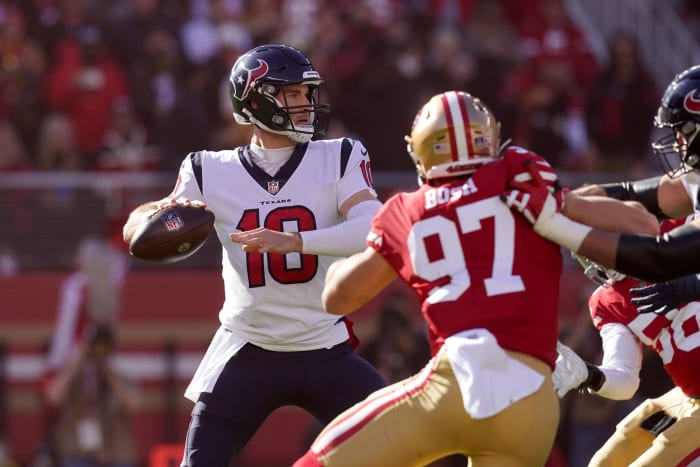
Cary Edmondson-USA TODAY Sports
Taking over a long-term rebuild project, Nick Caserio used his first pick as Texans GM on Mills (No. 67, one slot after Mond). Entering the league with considerably less fanfare than the five first-round QBs chosen last year, Mills outperformed most of them — despite a rough first leg as Houston’s starter. The Texans turned to the two-year Stanford starter, who only totaled 13 touchdown passes with the Cardinal, down the stretch and saw better results. Tyrod Taylor’s latest usurper finished ahead of Fields, Trevor Lawrence, and Zach Wilson in QBR and is positioned to be the Texans’ starter in 2022.
3 of 28
2019: Will Grier, Carolina Panthers
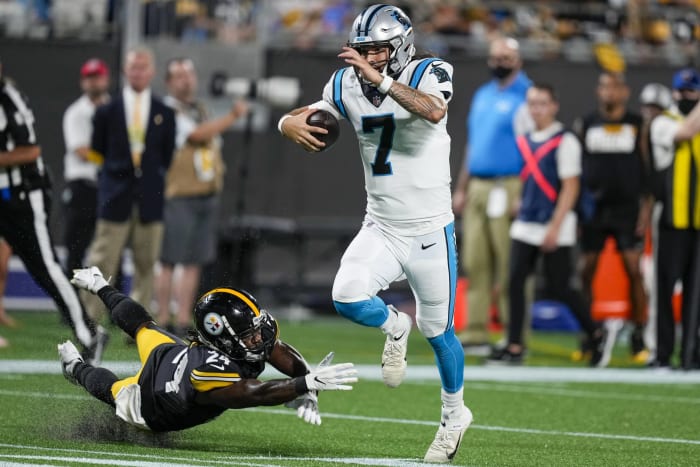
Jim Dedmon-USA TODAY Sports
Grier is currently one of Dak Prescott’s backups in Dallas, being waived by a Carolina coaching staff that was not around when he was drafted. The Marty Hurney-Ron Rivera regime drafted Grier 100th overall in 2019, slotting him behind a breaking-down Cam Newton. The former MVP’s season-ending foot injury that September, however, pushed former undrafted free agent Kyle Allen into the fray. Grier, a Florida transfer who starred for two years at West Virginia, made the final two starts that year. He threw no touchdown passes and four interceptions and has not appeared in a game since.
4 of 28
2018: Mason Rudolph, Pittsburgh Steelers

Charles LeClaire-USA TODAY Sports
With the Steelers coming off a 13-3 season, Ben Roethlisberger griped about the Rudolph pick at the time. The future Hall of Famer was probably right, though Rudolph is on a second contract with the Steelers. The Steelers put off adding a Big Ben heir apparent until the very end, but Rudolph, chosen 76th overall out of Oklahoma State, did receive the first extensive non-Roethlisberger QB work. The prolific Big 12 arm did not impress and lost his job briefly to ex-UDFA Duck Hodges. Remembered for being on the end of Myles Garrett’s helmet swing, Rudolph has seen the Steelers put Mitch Trubisky and Kenny Pickett ahead of him this offseason.
5 of 28
2017: Davis Webb, New York Giants
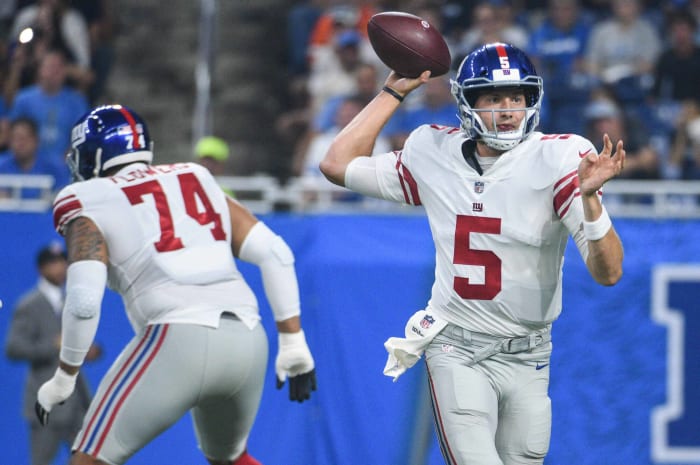
Tim Fuller-USA TODAY Sports
More of a dart throw during Eli Manning’s final years, Webb has played one game in five NFL seasons. The Giants took Webb, Jared Goff’s Cal successor, 87th overall but stashed him behind Manning and Geno Smith as a rookie. He did not make the Giants’ 53-man roster in 2018 and bounced to the Jets and Bills in subsequent years. The 6-foot-5 QB has since made his way back to the Giants, three coaches removed from the staff that drafted him, via reserve/futures contract.
6 of 28
2017: C.J. Beathard, San Francisco 49ers

Billy Hardiman-USA TODAY Sports
The 49ers’ decision not to draft Deshaun Watson or Patrick Mahomes should receive more heat than it takes, but Kyle Shanahan did not begin his San Francisco stay with a quarterback investment. Needing a starter post-Colin Kaepernick, Shanahan signed Brian Hoyer and drafted Beathard 104th overall in 2017. The Iowa alum has not exactly flopped, having played five seasons, and did make five starts as a rookie in between Hoyer and Jimmy Garoppolo’s time at the helm. He made seven more during Garoppolo injury periods in 2018 and 2020, holding an 18-13 TD-INT ratio. Beathard is tied to a two-year Jaguars contract.
7 of 28
2016: Jacoby Brissett, New England Patriots

Sam Navarro-USA TODAY Sports
Considering his profile when taken 91st overall and the quarterback situation on the team that selected him, Brissett has more than delivered on that investment. A two-year NC State starter after transferring from Florida, Brissett was thrown into the fire during Deflategate and traded for wideout Phillip Dorsett after one Patriots season. Brissett’s career has been defined by unexpected QB1 chances, with Andrew Luck’s injury and sudden retirement giving him 30 Colts starts in 2017 and 2019. He has since bounced from Miami to Cleveland, where more QB1 work is likely in his future due to Watson’s off-field trouble.
8 of 28
2016: Cody Kessler, Cleveland Browns
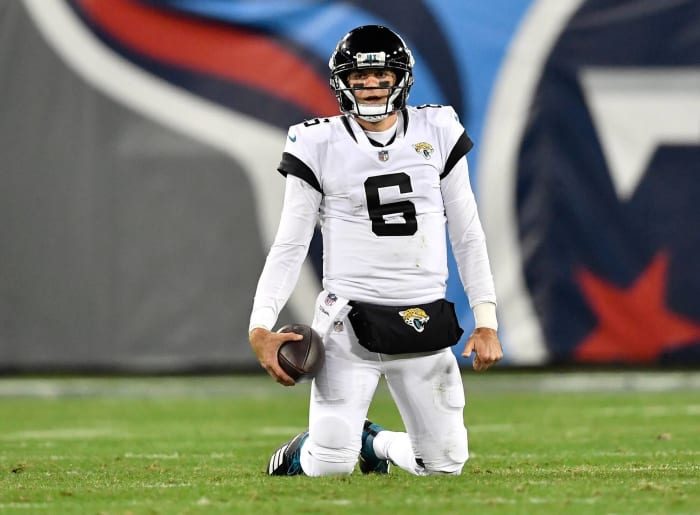
George Walker IV/Tennessean.com
Where QB prospects end up is quite important; Kessler drew a short straw. Drafted by a Browns team attempting a scorched-earth rebuild — to the chagrin of new coach Hue Jackson — Kessler came to Cleveland as 2016’s No. 93 overall pick. Injuries to Robert Griffin III and Josh McCown led to eight Kessler rookie-year starts. Eight losses commenced for a Browns team that went 1-15, though Kessler somehow threw just two INTs during that span. DeShone Kizer played in front of him on a worse Browns team in 2017. Kessler’s NFL run wrapped after a 2018 year in Jacksonville, when he broke Jason Mendoza’s heart by halting Blake Bortles’ starter stretch.
9 of 28
2015: Garrett Grayson, New Orleans Saints

Brett Davis-USA TODAY Sports
During Drew Brees’ 15-year New Orleans stay, Grayson was the franchise’s highest quarterback draft investment. The Saints took the Colorado State product 75th overall and kept him for two years, the second of which on the practice squad. But Grayson appeared in just one game with New Orleans, seeing Luke McCown start for an injured Brees for a game in 2015. Grayson played in just one game during four seasons as a pro. He bounced from the Saints to the Falcons to the Broncos and back to the Saints.
10 of 28
2015: Sean Mannion, St. Louis Rams

Jayne Kamin-Oncea-USA TODAY Sports
Chase Daniel has generated more attention; Nathan Peterman receives more ridicule. Somewhere in the middle of the seldom-used backup wing: Mannion, who has been an NFLer seven years and made three starts. The Rams took Mannion 89th overall out of Oregon State. While he started just one game in four years, because Sean McVay rested regulars in Week 17 in 2017, Mannion caught on with the Vikings and spent the past three seasons there. His two Minnesota starts came when Kirk Cousins rested in 2019 and contracted COVID-19 in 2021. Despite changing regimes, the Vikings re-signed Mannion in March.
11 of 28
2013: Mike Glennon, Tampa Bay Buccaneers

Jon Durr-USA TODAY Sports
Glennon has intrigued more than a few coaches during his career, beginning with NC State’s Tom O’Brien, who keyed Russell Wilson’s transfer by indicating the 2011 Wolfpack job was Glennon’s. After two years as the ACC team’s starter, Glennon went 73rd overall to the Bucs, who were souring on Josh Freeman. Glennon replaced Freeman as a rookie and made 13 starts. Later Jameis Winston’s backup, Glennon scored $19 million guaranteed from the Bears in 2017 (the QB market used to veer heavily toward sellers). Since Trubisky replaced him, Glennon has been with the Cardinals, Raiders, Jaguars, and Giants. The 6-foot-7 passer has enjoyed a solid run.
12 of 28
2012: Russell Wilson, Seattle Seahawks
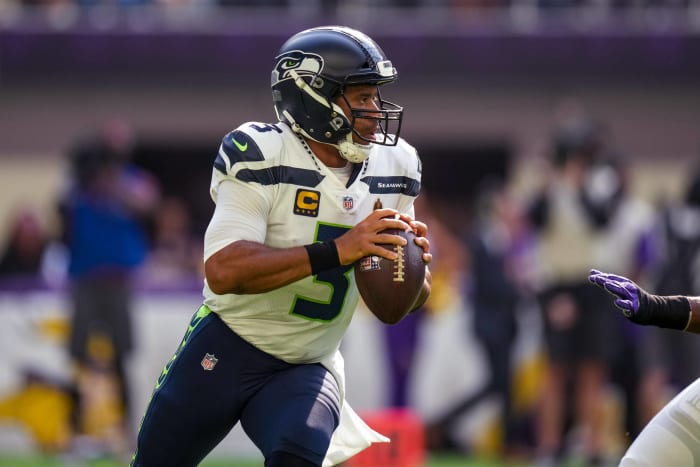
Brace Hemmelgarn-USA TODAY Sports
Wilson beat his former Wolfpack teammate to the pros and remains the crown jewel for teams hoping to hit big on a third-round QB. He shined after transferring to Wisconsin, completing 73% of his passes and dropping a 33-4 TD-INT ratio. Wilson was 2012’s sixth QB selected, going 75th overall. Despite the Seahawks’ three-year, $20.5 million Matt Flynn deal, Wilson never spent any NFL time as a backup. Flynn was gone by 2013 when Wilson began his Hall of Fame journey in earnest by piloting the Seahawks to back-to-back Super Bowls. The perennial Pro Bowler fetched Seattle five draft picks in March’s Denver trade.
13 of 28
2012: Nick Foles, Philadelphia Eagles

Mike DiNovo-USA TODAY Sports
2012 marks the exception for the third-round QB’s NFL plight. Wilson is Canton-bound, and the QB chosen after him has a Super Bowl MVP trophy and a statue at an NFL stadium. Rob Gronkowski’s QB at Arizona, Foles started three years with the Wildcats and went 88th overall during Andy Reid’s final Eagles draft. Although Foles has bounced around and has been benched by a few teams in recent years, he holds a share of the NFL’s single-game TD pass record (seven) and rescued the Eagles following Carson Wentz’s 2017 injury. Foles has made 56 NFL starts (with five teams) and has been twice traded, but he has probably achieved too much to be called a journeyman.
14 of 28
2011: Ryan Mallett, New England Patriots

Ken Murray/Icon Sportswire
Unlike the Saints, the Patriots took a few midround QBs during their future Hall of Famer’s stay. Mallett arrived via the draft choice obtained when the Pats sent Randy Moss back to the Vikings (No. 74 overall). After three years backing up Tom Brady, alongside Brian Hoyer, Mallett netted only a seventh-round pick in a 2014 trade with the Texans. He won a semi-memorable competition with Hoyer, a battle featured on 2015’s “Hard Knocks,” but lost the job in Week 1. Mallett ran afoul with Bill O’Brien and was cut midway through that season. The Arkansas alum finished his career with the Ravens but did last seven seasons.
15 of 28
2010: Colt McCoy, Cleveland Browns
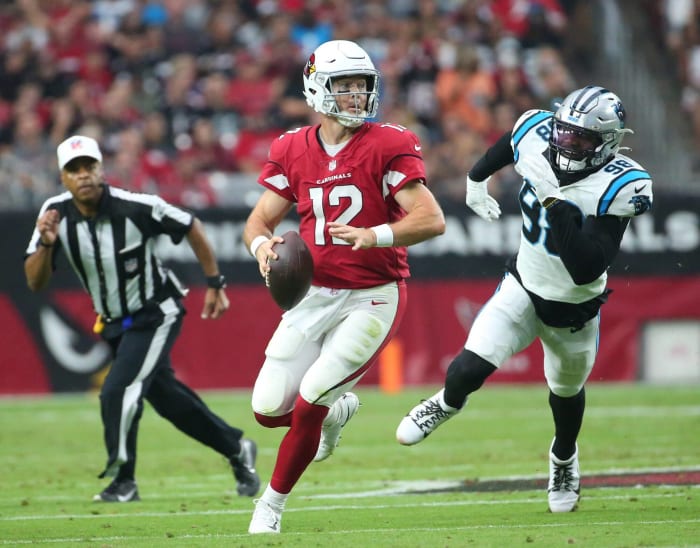
Michael Chow-Arizona Republic/USA TODAY NETWORK
Becoming one of the NFL’s better backup arms, McCoy has lasted 12 seasons. The Browns drafted McCoy in 2010, shortly after trading Brady Quinn and cutting Derek Anderson. McCoy, taken 85th overall after guiding Texas to the 2009 national title game, became the Browns’ primary starter over the next two years. Twenty-one of his 33 career starts came in Cleveland, but the team changed course and drafted Brandon Weeden in the 2012 first round. McCoy became a Jay Gruden favorite, being a Washington backup throughout the coach’s run. He most recently helped the Cardinals to the playoffs, winning two games in Kyler Murray’s stead.
16 of 28
2008: Kevin O’Connell, New England Patriots

Kelvin Ma/Icon Sportswire
Despite O’Connell arriving in New England the year Tom Brady missed 15 games, he threw only six career passes. Matt Cassel played in front of the San Diego State alum, whom the Pats took 94th overall in 2008. This was the earliest QB pick the Pats made since Brady became their starter, but O’Connell fizzled out, being waived after a year. While he lasted until 2012, bouncing around as a practice arm, O’Connell has climbed the coaching ladder swiftly. He landed Washington’s offensive coordinator job at 34, won a ring as the Rams OC, and is now the Vikings head coach. His career could rival Wilson’s in third-round annals one day.
17 of 28
2007: Trent Edwards, Buffalo Bills
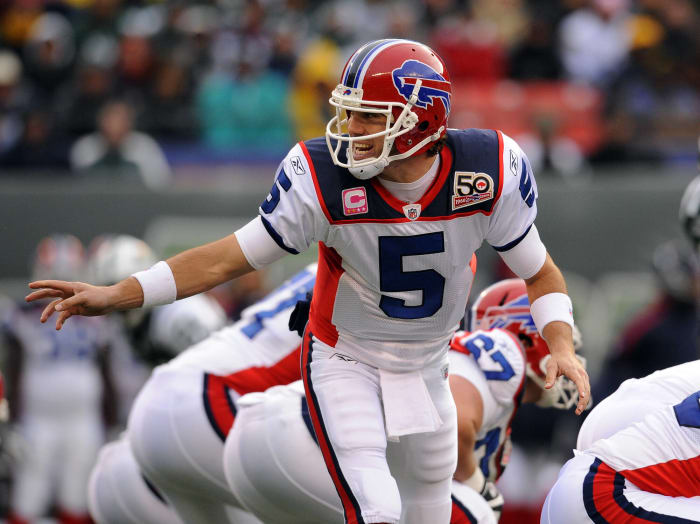
Rich Kane/Icon Sportswire
The Ravens traded two third-round picks and a seventh for Willis McGahee in 2007; Edwards came to Buffalo via the first of those choices. Chosen 94th overall out of Stanford, Edwards received more run than many third-round QBs this century. He replaced ex-first-rounder J.P. Losman early in his rookie season and won the Week 1 gig in 2008. Certainly not a standout, Edwards nevertheless guided the ’08 Bills to a 7-7 record in 14 starts and completed 66% of his throws. After starting ahead of Ryan Fitzpatrick in 2009, Edwards lost the job to the bearded future journeyman. Edwards bounced around as a practice arm until 2014.
18 of 28
2006: Charlie Whitehurst, San Diego Chargers

George Walker IV/The Tennessean
Tabbed “Clipboard Jesus” during his lengthy QB2 run, Whitehurst blazed the trail for Sean Mannion. In 11 NFL seasons, Whitehurst made nine starts. The Chargers, in their first post-Drew Brees offseason, drafted Whitehurst 81st overall out of Clemson. He backed up the indestructible Philip Rivers for four seasons, throwing zero passes as a Charger, before being traded to the Seahawks in 2010. Whitehurst did start Seattle’s Week 17 do-or-die game that year, enabling a 7-9 team to enter the playoffs and thus allowing “Beastquake” to happen, but his most QB1 run came as a Titan in 2014. Whitehurst made five starts that year.
19 of 28
2006: Brodie Croyle, Kansas City Chiefs

Jeff Moffett/Icon Sportswire
Famously avoiding first-round QB investments between Todd Blackledge and Patrick Mahomes, the Chiefs made three second- and third-round choices in that span. Croyle was the final such choice. Coming to the Chiefs after a career at pre-Nick Saban Alabama, Croyle qualifies as a notable attempt by the franchise. The Chiefs gave Croyle a shot as a starter in the late 2000s but were rebuilding by that point. Croyle went 0-10 as a starter, and his knee injury in 2008 closed any QB1 path. The Chiefs traded for Matt Cassel the following March. Croyle hung around through the 2011 season, playing that year with the Cardinals.
20 of 28
2005: Charlie Frye, Cleveland Browns

Davis Turner/Icon Sportswire
The Browns yo-yoed between rookies and veterans during their first 10 years back as a team. They drafted Frye during Trent Dilfer’s season at the controls. Frye, who had played at Akron, went 67th overall and finished his rookie year as Cleveland’s starter. He kept going in 2006, starting 13 games during the second Romeo Crennel season. Despite the Browns trading back into the 2007 first round to take Brady Quinn, Frye opened the ’07 season as their starter. Crennel benched him for Derek Anderson in Week 1; Frye did not throw another pass as a Brown. Frye finished his career with the Seahawks and Raiders.
21 of 28
2005: Andrew Walter, Oakland Raiders

Christophe Dupont Elise/Icon Sportswire
Arriving during one of the Raiders’ dysfunction peaks, Walter was thrown into a rough situation in his second season. The former Arizona State QB, whom the Raiders took 69th overall, sat behind Kerry Collins as a rookie but was in the lineup in 2006. The Raiders offense cratered during Art Shell’s second stay as head coach — a one-year stopover — and Walter took over in September after an Aaron Brooks chest injury. The backup did lead Oakland to its two wins that season, but he sported a 3-13 TD-INT ratio. The Raiders still kept Walter around for two more years as one of JaMarcus Russell’s backups.
22 of 28
2005: David Greene, Seattle Seahawks
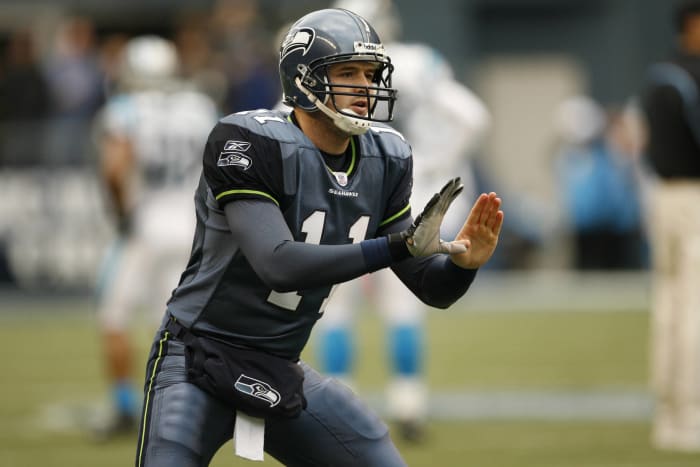
David Gonzales/Icon Sportswire
Greene succeeded Quincy Carter at Georgia and started four seasons for the Bulldogs, enticing the Seahawks to take him 85th overall at one of the franchise’s high points. Greene did not prove a threat to Matt Hasselbeck, who was entrenched as Seattle’s starter and played behind Seneca Wallace. Greene did not see any game action as a pro, with the Seahawks cutting him after two years. He bounced around as a practice performer until 2008.
23 of 28
2004: Matt Schaub, Atlanta Falcons
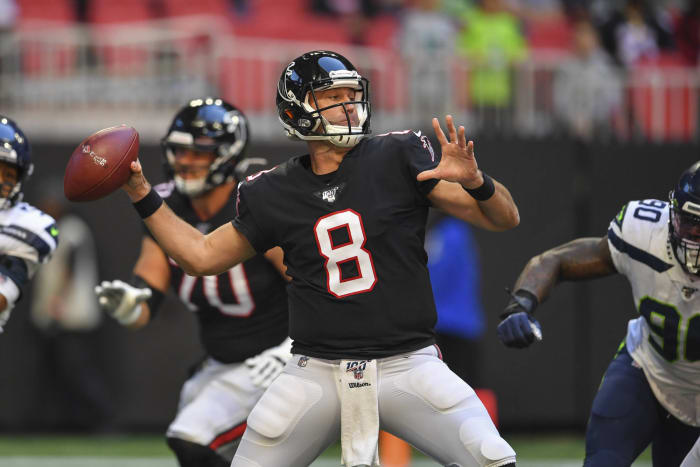
Dale Zanine-USA TODAY Sports
While Schaub is best known for his success with the Texans, being their longest-tenured starting quarterback, he rewarded the team that drafted him as well. The Falcons took the Virginia passer 90th overall, slotting him behind Michael Vick ahead of the Pro Bowler’s fourth season. Beginning its Bobby Petrino “regime,” the Falcons traded Schaub three months before Vick’s controversy swirled. Schaub took over for David Carr and made two Pro Bowls with Houston, leading the team for six-plus years. Atlanta benefited from Schaub’s twilight years as well; the 17-year veteran spent his final five seasons as Matt Ryan’s backup.
24 of 28
2003: Dave Ragone, Houston Texans

John Cordes/Icon Sportswire
Back to the coaching wing of this collection, Ragone did not pan out as a player but has resurfaced on the sidelines. In their second year of existence, the Texans took Ragone to back up David Carr. This did produce two Ragone rookie-year starts (both losses), and the Louisville southpaw spent three years in Houston. The Texans cut him in 2006, however. Ragone is entering his second season as the Falcons’ offensive coordinator, coming over after four years with the Bears.
25 of 28
2003: Chris Simms, Tampa Bay Buccaneers

Chris Livingston/Icon Sportswire
Tampa Bay drafted Simms near the end of the third round (97th) but received some value from the move, which capped a two-lefty third round. The second-generation NFL QB’s most notable stretch came in 2005 when he replaced Brian Griese and quarterbacked the Bucs to the playoffs. This included a shootout win over Washington that November, though Joe Gibbs’ team won the wild-card rematch. The future NBC regular lasted until 2009 when a scary spleen injury ended his short Broncos stint.
26 of 28
2002: Josh McCown, Arizona Cardinals

Robert Deutsch-USA TODAY Sports
It appears McCown will join O’Connell and Ragone as a full-time coach, but he recently wrapped one of the longest and most interesting careers in quarterback history. Counting his time as the Eagles’ remote practice squad QB during the first COVID-19-impacted season, McCown played 18 NFL seasons and 19 as a pro. (He spent the 2010 slate in the United Football League.) The Cards draftee (81st overall) logged 76 starts, beginning his run post-Jake Plummer and pre-Kurt Warner in Arizona, and spent time with 12 NFL teams. His only playoff game came in 2019 when he relieved Carson Wentz in a wild-card game.
27 of 28
2000: Giovanni Carmazzi, San Francisco 49ers
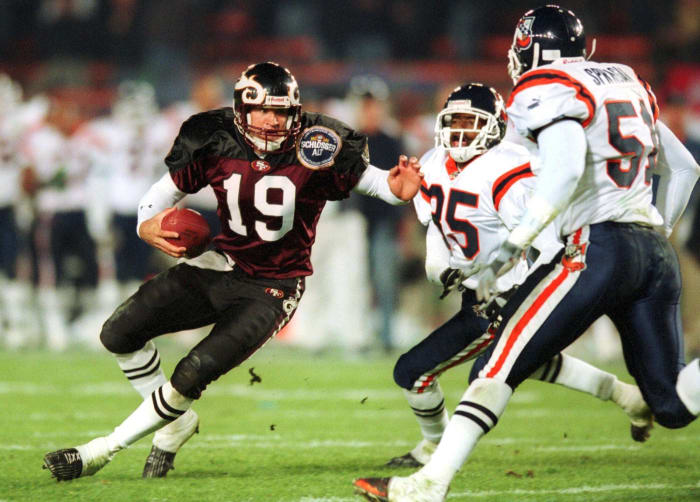
Christof Koepsel/Bongarts/Getty Images
We move to the “Brady 6” section of the list. Carmazzi was the second quarterback taken in 2000, going 65th overall out of Hofstra, after only Chad Pennington had come off the board. Carmazzi spent two seasons with the 49ers but never played in an NFL game. He did see an extensive run with NFL Europe’s Rhein Fire during that time and later played in the CFL. The 49ers found Jeff Garcia’s backup four rounds later, in Louisiana Tech’s Tim Rattay, who played six seasons with the team.
28 of 28
2000: Chris Redman, Baltimore Ravens

Todd Kirkland/Icon Sportswire
The third QB taken in 2000, Redman enjoyed a unique career interrupted by a stop in the Arena League and the insurance business. Shortly after signing Trent Dilfer, the Ravens took Redman 75th overall. Behind Dilfer and Tony Banks as a rookie, Redman moved into Baltimore’s starting lineup in 2002 — after both were gone and before Kyle Boller’s arrival — but did not play during the 2005 and ’06 seasons. Bobby Petrino’s Atlanta arrival preceded a call to his former Louisville QB, pulling Redman out of the insurance game. Even after Petrino’s quick exit, the Falcons kept Redman on until 2012. He collected more than $12 million from the team.
[ad_2]
Source link




